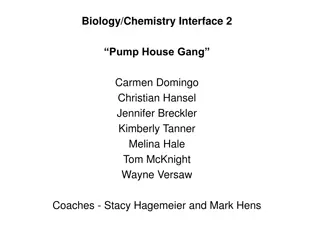Understanding Membrane Transport in Plant Cells
Plant cells rely on membrane transport to facilitate the movement of molecules across their plasma membrane. This process involves passive and active transport mechanisms, with the help of specialized proteins such as channels, carriers, and pumps. Channels serve as selective pores for ions and water, allowing for passive movement. Understanding the dynamics of membrane transport is crucial for plant cell functions and responses to external stimuli.
Download Presentation

Please find below an Image/Link to download the presentation.
The content on the website is provided AS IS for your information and personal use only. It may not be sold, licensed, or shared on other websites without obtaining consent from the author. Download presentation by click this link. If you encounter any issues during the download, it is possible that the publisher has removed the file from their server.
E N D
Presentation Transcript
BOT323 SOLUTE TRANSPORT Delivered by Ashish Sharma, Ph.D.
INTRODUCTION Plant cells are separated from their outer environment by plasma membrane. Besides forming a barrier, membrane also must facilitate the reversible traffic of selected molecules through it. Plasma membrane also receives signals from its surroundings. Molecular and ionic movement from one location to another is known as transport.
PASSIVE AND ACTIVE TRANSPORT The spontaneous downhill movement of molecules is termed passive transport. The movement of substances against or up a gradient of chemical potential (e.g., to a higher concentration) is termed active transport.
MEMBRANE TRANSPORT PROCESS Biological membranes are permeable to ions and many large polar molecules like sucrose. This permeability is due to the presence of transport proteins that facilitate the transport of these molecules through the membrane. Transport proteins are highly specific for solutes. In any organism, atleast 10% of its genome encodes for transport proteins.
Three enhance the movement of solutes across membranes: types of membrane transporters Channels, Carriers, and Pumps
FIGURE Three classes of membrane transport proteins: channels, carriers, and pumps.
Transport proteins: CHANNELS CHANNELS are transmembrane proteins that function as selective pores, through which molecules or ions can diffuse across the membrane.
Transport through channels is always passive. Channel transport is limited mainly to ions or water. Transport through a channel may or may not involve transient binding of the solute to the channel protein. Channels are not open all the time: Channel proteins have structures called gates that open and close the pore in response to external signals. Signals that can open or close gates include voltage changes, hormone binding, or light.
Channels generally work only in one direction. Like anion channels always expel the anions out of the cell while calcium channels always lead to uptake of calcium into the cell. Only exception to this is the potassium channel which can be inward rectifying and/or outward rectifying.
Transport proteins: CARRIERS Carrier proteins do not have pores that extend completely across the membrane. Carriers specialize in transport of specific organic metabolites. Rate of transport by a carrier is much slower in comparison to the channel proteins. Carrier-mediated transport can be either passive or active, and it can transport a much wider range of possible substrates.
Passive transport through the carriers can be referred to as facilitated diffusion. However carrier mediated active transport can be Primary active transport, or Secondary active transport.
Transport proteins: PUMPS The membrane proteins that carry out primary active transport are called pumps. Most pumps transport ions, such as H+ or Ca2+. Ion pumps can be further characterized as either electrogenic or electroneutral. Electrogenic transport refers to ion transport involving the net movement of charge across the membrane. Electroneutral transport, involves no net movement of charge.
Ion pumps mainly belong to one of these three categories i.e. Plasma membrane H+ ATPase, Vacuolar H+ ATPase, and H+ pyrophosphatase Transport by pumps is generally outwards. Hence, uptake of molecules by cells generally occur by secondary active transport.
Secondary Active Transport In this method solutes can be actively transported across a membrane against their gradient of electrochemical potential is by coupling of the uphill transport of one solute to the downhill transport of another. Transporters involved in secondary active transport are one of the two types: Symporters, or Antiporters.























